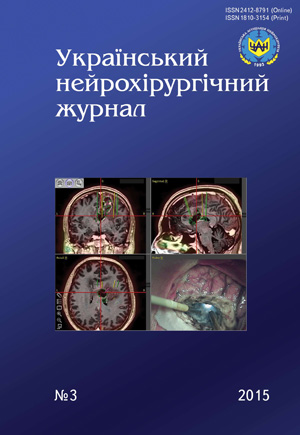The study of cognitive evoked potentials (P 300) in boxers with repeated traumatic brain injury
DOI:
https://doi.org/10.25305/unj.50265Keywords:
traumatic brain injury, boxer, cognitive evoked potentialAbstract
Objective. The purpose is to justify the possibility of early detection of cognitive impairment (CI) in boxers with repeated traumatic brain injury (TBI) through the study of cognitive evoked potentials (CEP).
Materials and methods. We examined 52 amateur boxers aged 16 to 31 years, who had had repeated mild TBI. The control group consisted of 30 healthy patients of similar age. Held: clinical and neurological examination, magnetic resonance imaging (MRI) of the brain, ultrasonography (USG) of the vessels of the head and neck, computed electroencephalography (CEEG), neuropsychological testing (NPT), registration CEP P300.
Results. The latent period (LP) cognitive complex P300 in the normal range occurred in boxers in 55.77% of observations, while in the control group in 86,67%. The amplitude of the cognitive complex P300 in representatives of the main group was in the normal range in 61,54%, the representatives of the control group - 90.00%. Change the settings of CEP representatives of the core group met more frequently among boxers-men over 26 years, heavyweights and those who had more than 200 fights. The data obtained evidence of decreased cognitive function and memory. Assessing the severity of CI in boxers can say that in all the cases had minor violations.
Conclusions. The study CEP can be used even in the preclinical stages of CI for early diagnosis and quality control of regenerative processes and evaluate the effectiveness of corrective actions.
References
1. Volkov EV. Rol' sosudistykh i immunologicheskikh narusheniy v formirovanii travmaticheskoy bolezni golovnogo mozga s sochetannoy chelyustno - litsevoy travmoy u detey [The role of vascular and immunological disorders in formation of traumatic disease of the brain with associated maxillofacial trauma in children] [dissertation]. Moscow (Russia): Institute for Advanced Studies of the Federal Medical-Biological Agency of Russia; 2015. Russian.
2. Shakhbanov SA. Posttravmaticheskiye kognitivnyye rasstroystva i ikh rol’ v otsenke stepeni ogranicheniya zhiznedeyatel’nosti bol’nykh trudosposobnogo vozrasta [Posttraumatic cognitive disorders and their role in assessing disability degree in patients of working age] [dissertation]. :St. Petersburg (Russia): St. Petersburg Medical Academy of Postgraduate Education, Federal Agency for Health and Social Development; 2010. Russian.
3. Bernick C, Banks S, Phillips M, Lowe M, Shin W, Obuchowski N, Jones S, Modic M. Professional fighters brain health study: rationale and methods. Am J Epidemiol. 2013;178(2):280-286. [CrossRef] [PubMed]
4. Smith DH, Johnson VE, Stewart W. Chronic neuropathologies of single and repetitive TBI: substrates of dementia? Nat Rev Neurol. 2013;9(4):211-221. [CrossRef] [PubMed]
5. Gnezditskiy VV, Kulikova SN, Koshurnikova EE. [EEG and P300 peculiarities in cognitive disorders evaluation]. Funkts Diagnostika. 2009;(3):43–49. Russian. [eLIBRARY]
6. Morozova VA, Yevtushenko SK, Morozova TM. [Multifocal Event-Related Evoked Potentials in Early Diagnostics of Сognitive Disintegration: Clinical And Neurophysiologic Interpretation]. Mezhdunar Nevrol Zhurn. 2012;(3):26-41. Russian. [eLIBRARY]
7. Bahadova EM, Karpov SM, Apaguni AE, Karpova EN, Apaguni VV, Kaloev AD. [Long-term effects mine-blast injuries in neurophysiological state of the brain]. Fundamental Research. 2014;(2):28-33. Russian.http://rae.ru/fs/?section=content&op=show_article&article_id=10002806&lng=en. <a href=">[eLIBRARY]
8. Grygorova IA, Kufterina NS. [Neurophysiologic Analysis of Young People after Mild Traumatic Brain Injury]. Mezhdun Nevrol Zhurn. 2011;(7):43-46. Ukrainian. [eLIBRARY]
9. Oknina LB, Sharova EV, Zaĭtsev OS, Zakharova NE, Masherov EL, Shekut'ev GA, Kornienko VN, Potapov AA. [Long-latency components (N100, N200 and P300) of acoustic evoked potentials in prediction of mental recovery in severe traumatic brain injury]. Zh. Vopr Neirokhir Im NN Burdenko. 2011;75(3):19-30. Russian. [PubMed]
10. Chebotaryova LL, Stepanenko IV, Globa MV, Solonovych OS, Suliy LM. [Сlinical and neurophysiological estimation of cognitive function in patients with chronic cerebral ischemia in a period of recovery after surgery]. Ukrainian Neurosurgical Journal. 2014;(1):10-15. Ukrainian. [Abstract/Full Text]
11.Karpov SM, Lubenec AE, Christoforando DU, Sharipov EM. [Kognitive of infringements in the acute period of craniocerebral trauma at children]. Fundamental Research. 2011;(11-1):46-48. Russian.[Publisher Full Text] [eLIBRARY]
Downloads
Published
How to Cite
Issue
Section
License
Copyright (c) 2015 Andriy Muravskiy, Lidiya Chebotariova, Oleksandr Solonovich

This work is licensed under a Creative Commons Attribution 4.0 International License.
Ukrainian Neurosurgical Journal abides by the CREATIVE COMMONS copyright rights and permissions for open access journals.
Authors, who are published in this Journal, agree to the following conditions:
1. The authors reserve the right to authorship of the work and pass the first publication right of this work to the Journal under the terms of Creative Commons Attribution License, which allows others to freely distribute the published research with the obligatory reference to the authors of the original work and the first publication of the work in this Journal.
2. The authors have the right to conclude separate supplement agreements that relate to non-exclusive work distribution in the form of which it has been published by the Journal (for example, to upload the work to the online storage of the Journal or publish it as part of a monograph), provided that the reference to the first publication of the work in this Journal is included.









